ERANTHEMUM
Eranthemum
L., Sp. Pl. 1:9.1753; Gen. Pl. ed. 5: 9. 1754; DC., Prodr. 11: 445. 1847; Benth. & Hook. f., Gen. Pl. 2: 1097. 1876; Clarke in Hook. f., Fl. Brit. Ind. 4: 497. 1885; Cooke, Fl. Pres. Bomb. 2: 468. 1906; Hu & Daniel, Fl. China 19: 432; Malik & Ghafoor, Fl. Pak. @ eFloras.org p.75.
Shrubs or perennial erect herbs. Cystoliths present. Leaves opposite, simple, petiolate; leaf blade margin entire or crenate. Inflorescences terminal or rarely axillary, spikes, lax, sometimes several forming a panicle. Bracts sometimes coloured, subleaf-like, large; bracteoles small, narrow. Calyx 5-lobed, lobes narrow, subequal. Corolla subsalverform; tube basally cylindric, long, slender, throat sometimes inconspicuous; limb 5-lobed, lobes obovate, subequal, contorted in bud. Stamens 2, inserted below throat; anthers bithecous; thecae parallel, muticous; staminodes 2, clavate or filiform. Carpels 2, syncarpous; ovary 2-locular with 2 ovules per loculus, placentation axile; style filiform, glabrous or pubescent; stigma 2-lobed, lobes unequal. Capsule clavate with a solid stalk at the base, 4-seeded, retinacula present. Seeds discoid, compressed, pubescent with hygroscopic trichomes.
23 species
Eranthemum pulchellum
Eranthemum pulchellum
Andrews, Bot. Repos. 2: t. 88. 1800; Fosberg & Sachet, Taxon 2:135.1953; Sharma & Kachroo, Fl. Jammu (Illustr.) 2: t. 211.1983; Kaur & Sharma, Fl. Sirmaur 485. 2004; Stewart in Nasir & Ali, Ann. Cat. Vasc. Pl. W. Pak. & Kashm. 675.1972; Hara in Hara et al., Enum. Fl. Pl. Nep. 3:177.1982; Malik & Ghafoor, Fl. Pak.@eFloras.org p. 76. Daedalacanthus nervosus (Vahl) T. Anderson, J. Linn. Soc. Bot. 9:487.1867; Collett, Fl. Siml. ed. 2: 371.1921 (Reprint 1980); Clarke in Hook. f., Fl. Brit. Ind. 4: 418. 1885; Pseuderanthemum pulchellum (Andrews) Merr., Philipp. J., C 7: 248.1912.
Perennial, large, glabrous, erect, well-branched shrub, 0.6-2.0 m tall. Leaves opposite, simple; petiole 1.5-2.0 cm long, winged; leaf blade elliptic or ovate-elliptic, dark green, coriaceous, 10-15 cm x 4.5-6.0 cm, prominently nerved, lateral nerves 7-10 pairs, glabrous or hairy on nerves beneath, margin entire, apex acuminate, basally attenuate. Flowers blue, bisexual, +/- actinomorphic, hypogynous, ca. 2.5-3.0 cm long, in short dense 2.5-7 mm long spikes forming a close terminal panicle; bracts leafy, variegated green and white, ovate-elliptic to obovate, 12-15 mm x 6-8 mm, shortly acuminate, glabrous or puberulous enclosing the lower part of the flower; bracteoles shorter than calyx, 4-6 mm x 1.0 mm, linear-lanceolate, acute. Calyx ca. 1 cm long, 5-lobed, lobes equal or subequal, linear-lanceolate, ca. 6 mm long, minutely pubescent. Corolla blue, narrow, ca. 3 cm long ca. 2 cm across, glabrous; tube ca. 2 cm long, dilated near the top; limb spreading, oblique, lobes 5, +/- equal, ca. 10 mm x 6 mm, patent, obtuse. Stamens 2, fertile, exserted; filaments ca. 2.8 cm long; anthers bithecous, 3-4 mm long, oblong, blunt; staminodes 2 included. Carpels 2, syncarpous; ovary ca. 3 mm long, bilocular with 2 ovules per loculus, placentation axile; style filiform, ca. 3 cm long, hairy; stigma bifid, 1.5 mm, blue.
Capsule ca. 12-15mm long, oblong, shortly stalked, 4-seeded, retinacula present. (Fruits not observed)
Common Names: Blue Sage; Gulsham, Nili Aaboli (Hindi)
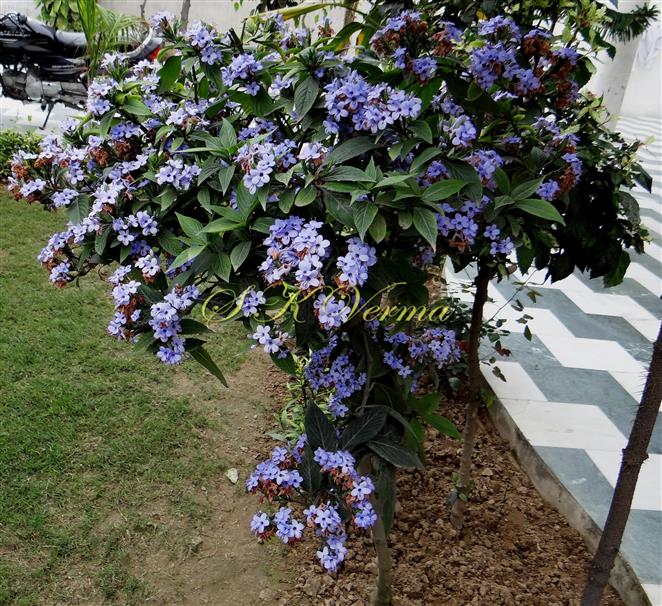
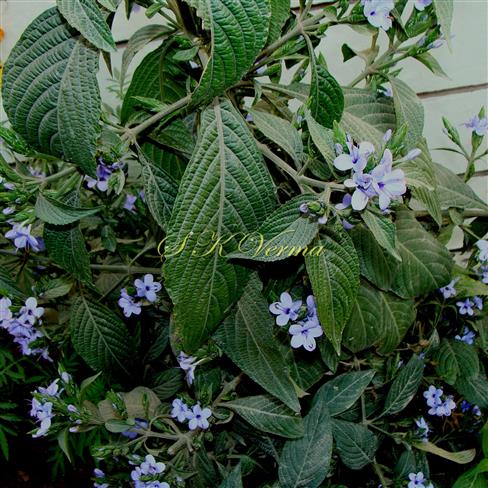
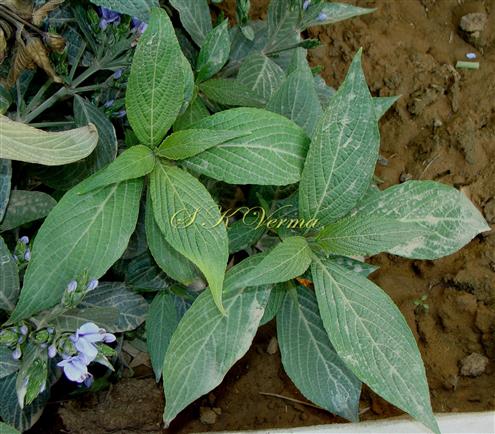
-DSC03172.jpg)
 and Flower-DSC04376.jpg)
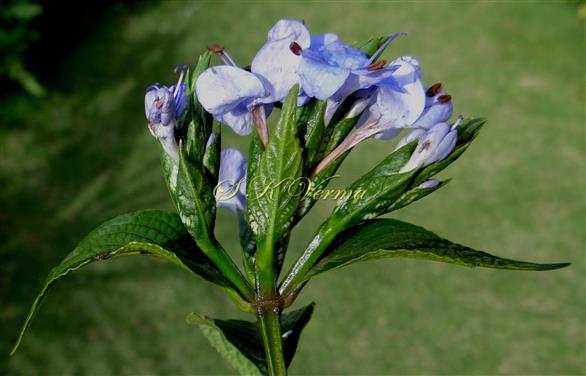
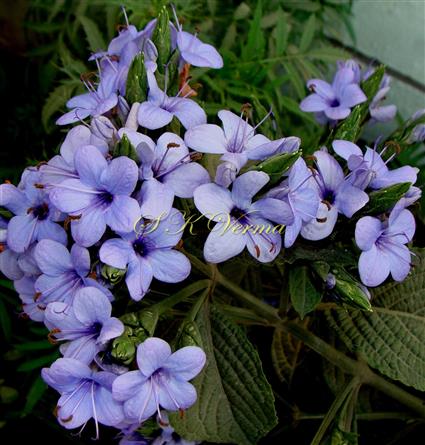
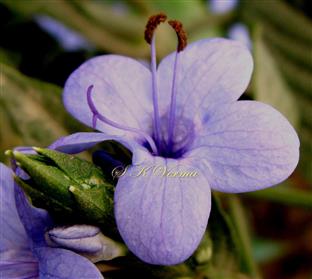




-DSC03172.jpg)
 and Flower-DSC04376.jpg)


